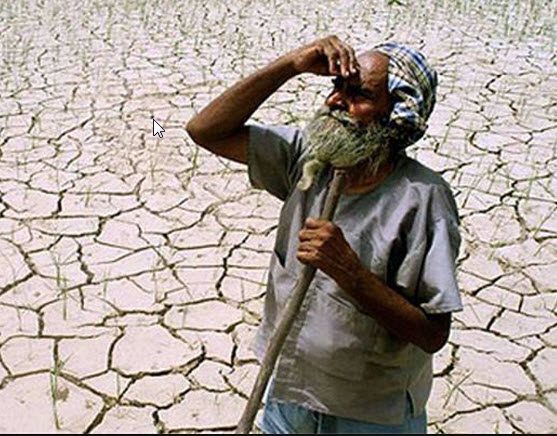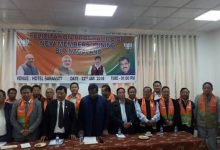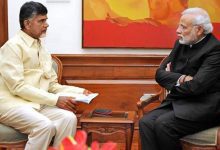After four years in power already, the Modi government achieving neither inclusive growth nor jobs in millions promised in 2014, should now wake up to the plight of distressed farmers over years and of the rural and urban poor. The Modi Exercise is thus designed to focus on the needs of rural areas as well as other sectors from agriculture to infrastructure – a modified version of the “Garibi Hatao” slogan of the 1970s. Here’s an analysis, for Different Truths.
 An elaborate exercise in “friendliness” to the farmer in distress for long, to the small business, devastated by demonetisation, and “healthcare” for poorer sections, crafted by Prime Minister Modi, was faithfully projected by Finance Minister Arun Jaitley in the Union Budget for 2018/19.
An elaborate exercise in “friendliness” to the farmer in distress for long, to the small business, devastated by demonetisation, and “healthcare” for poorer sections, crafted by Prime Minister Modi, was faithfully projected by Finance Minister Arun Jaitley in the Union Budget for 2018/19.
That it is all politically timed for safeguarding the strength of ruling BJP-led NDA in a critical election year in states leading to Lok Sabha polls in 2019 is patent.
Otherwise, how after four years in power already, the Modi government achieving neither inclusive growth nor jobs in millions promised in 2014, should now wake up to the plight of distressed farmers over years and of the rural and urban poor. The Modi Exercise is thus designed to focus on the needs of rural areas as well as other sectors from agriculture to infrastructure – a modified version of the “Garibi Hatao” slogan of the 1970s.
 Modi thumped the desk for every announcement of Jaitley on higher institutional credit to farmers and extension of minimum support prices (MSP) at one and half times the cost of production cost, now available to rabi crops, for all unannounced Kharif crops. The MSP rise, marketing funds and other proposals announced in agriculture and animal husbandry, duly applauded, were all designed toward the promised objective of doubling farmers’ income by 2022.
Modi thumped the desk for every announcement of Jaitley on higher institutional credit to farmers and extension of minimum support prices (MSP) at one and half times the cost of production cost, now available to rabi crops, for all unannounced Kharif crops. The MSP rise, marketing funds and other proposals announced in agriculture and animal husbandry, duly applauded, were all designed toward the promised objective of doubling farmers’ income by 2022.
Jaitley said his other priorities in the budget were good healthcare to the economically less privileged, infrastructure expansion, and working with states to provide more resources for improving the quality of education. Laudable as all these goals are, there are no readily available institutional mechanisms nor funding at the central or state levels. In food also, the scale of procurement and the methodology for arriving at MSP were left unsaid for exchequer cost calculations.
It is understandable for the prime minister to bestir himself at a time the opposition has begun to make a gradual recovery to be able to challenge the ruling BJP in states first and later in the Lok Sabha elections. After Gujarat, Rajasthan is sending out strong signals of the changing voter mood. No doubt, the prime minister would become hyper-active henceforth, choosing all platforms, to thunder against opposition parties with allegations of corruption.
The Modi government thus far cannot claim to have mastered the art of seizing black money and benami properties and providing a corruption-free regime, leave alone the economic growth and lack of private investments in these four years. Nor is there anything of substance in Jaitley’s latest (fifth) budget to trigger “animal spirits” for business investment to revive.
 Taking the budget overall, given the appalling deficits – with deferred fiscal consolidation plans – the finance minister has sought to distract attention and making his lengthy speech a review of “achievements” in the first four years in terms of “yojanas” of the Prime Minister for “vikas”, partly under implementation, and “fundamental structural” reforms undertaken like GST, code on bankruptcy, etc.
Taking the budget overall, given the appalling deficits – with deferred fiscal consolidation plans – the finance minister has sought to distract attention and making his lengthy speech a review of “achievements” in the first four years in terms of “yojanas” of the Prime Minister for “vikas”, partly under implementation, and “fundamental structural” reforms undertaken like GST, code on bankruptcy, etc.
Certainly, this government has fiercely and forcefully been enforcing Aadhaar in all spheres downplaying citizen’s rights including privacy, in a vast country of low literacy and large segments of poverty. A deliberate policy of digitalisation toward a ‘cash-less’ economy is being pursued with a majoritarian push unmindful of ground realities even as more basic needs and requirements of the people are downplayed.
The prime minister said with the focus now on “ease of living” – away from “ease of doing business” – the budget envisages an “unparalleled” shift in the health sector – providing healthcare to nearly 50 crore Indians at Rs. five lakh a year for quality treatment. The budget makes a token provision of Rs. 2,000 crore. Based on a research study, health insurance for 10 crore poor families would cost Rs. one lakh crore and the annual premium would be Rs.10,000 crore even at 2 percent of the sum assured (Rs. 5 lakh).
 Health, as a state subject, requires serious centre-state commitments for such major healthcare programmes expected to cast a heavy burden for both Union and state exchequers. While the budget describes it as the world’s largest government-funded healthcare programme (Ayushman Bharat plan), at this stage it is more like floating a balloon. Healthcare costs are very high in the country, though may look cheaper for the wealthy abroad visiting India, and have become unaffordable even for the affluent nationals. Since the government has to rely on private sector substantially, the specialty hospitals and insurance companies would be getting richer.
Health, as a state subject, requires serious centre-state commitments for such major healthcare programmes expected to cast a heavy burden for both Union and state exchequers. While the budget describes it as the world’s largest government-funded healthcare programme (Ayushman Bharat plan), at this stage it is more like floating a balloon. Healthcare costs are very high in the country, though may look cheaper for the wealthy abroad visiting India, and have become unaffordable even for the affluent nationals. Since the government has to rely on private sector substantially, the specialty hospitals and insurance companies would be getting richer.
On the taxation side, Jaitley has now come to believe that medium, small and micro enterprises (MSMEs) would lead economic consolidation in India. He had earlier refused to acknowledge the damage done to this sector by demonetisation both in terms of loss of cash for transactions and lakhs and lakhs of workers being thrown out of jobs. The budget extends reduced corporate tax at 25 percent for MSM companies with turnover up to Rs. 250 crore and Jaitley hopes with higher investible surplus these enterprises could create more jobs.
For jobs, the finance minister relies more on new schemes in the agriculture, small-scale and health sectors and offered a selective subsidy, where employees would be kept for three years at least in any new start. The economy must first get back to sustained growth for jobs.
The government sees “green shoots” on the economic horizon and has assumed that GDP would grow at 11.5 percent at current prices (7.2 percent in real terms) in 2018/19 after the slowdown to 6.7 percent in fiscal 2018. The medium-term outlook is clouded with global developments not entirely benign. The rising trend in oil prices would affect the budget arithmetic as also any fall-out from the budget on consumer prices.
The government’s inability to contain fiscal deficit at 3.2 percent of GDP in 2017/18, attributed to less than expected GST revenues (net) and a decline in non-tax revenues, is compounding the outlook for inflation. From the now enhanced 3.5 percent of GDP, the budget assumes fiscal deficit at 3.3 percent in 2018/19. This is a temporary blip, according to the finance ministry, which sees more buoyant revenues with a reformed GST and strategic disinvestments planned. The revised consolidation plan targets fiscal deficit at 3.0 percent in 2021.
S. Sethuraman
©IPA Service
Photos from the Internet
#GaribiHatao #GDP #GST #MSP #Healthcare #FiscalDeficit #Poverty #PrimeMinisterOfIndia #IPA #DifferentTruths





 By
By
 By
By

 By
By